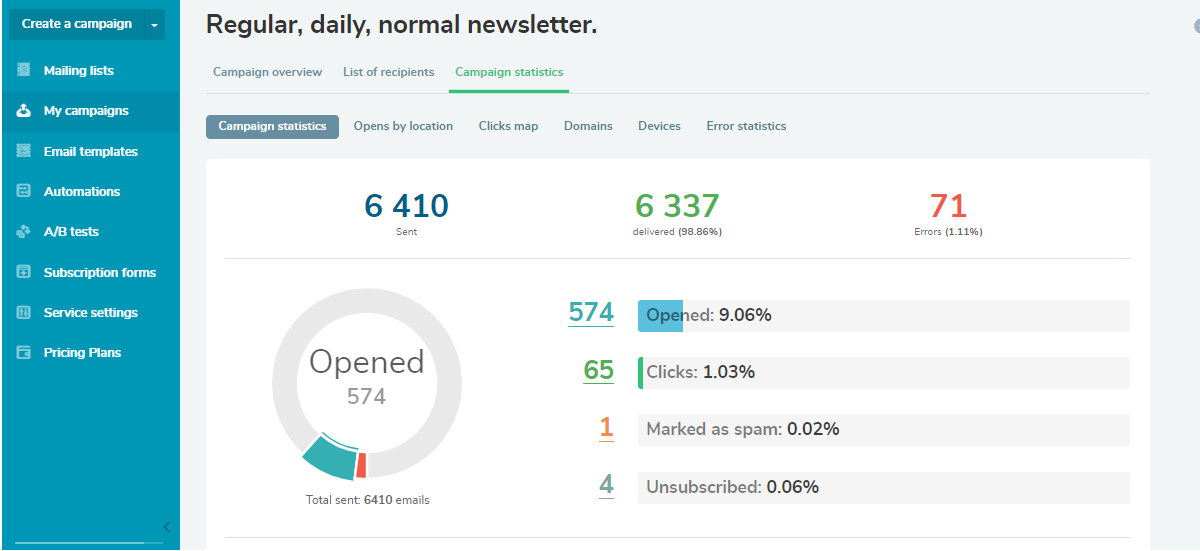An unsubscribe rate is a measure that indicates the percentage of users who have opted-out from the mailing list after an email campaign. The unsubscribe rate impacts email deliverability, so a large number of unsubscribers leads to negative consequences from email service providers like Gmail, Yahoo, and Outlook.
Watch this video, where the expert from Sleeknote gives a framework for reducing the unsubscribe rate and keeping subscribers engaged.
The Role of the Unsubscribe Rate
Marketers monitor the unsubscribe rate to measure email marketing strategy success along with other metrics like open rate and click-through rate. With SendPulse, you can track the number of unsubscribes after every email campaign sent.
Unsubscribes are a sort of a self-cleaning of your mailing list, meaning that unengaged people simply stop communication. However, the more users unsubscribe, the more it damages your sender reputation.
A high unsubscribe rate indicates that some elements of your strategy have gaps and you need to take a closer look at your email campaigns. Perhaps the email sending volume is too high, the content is irrelevant to users’ expectations, or your email templates look unprofessional and outdated.
Before you start recollecting all of the weak points of your emails, learn how to get that unsubscribe rate first.
How to Calculate the Unsubscribe Rate
To determine the unsubscribe rate, you need to know two metrics: the number of delivered emails and the number of unsubscribes. You can find these metrics in the statistics of each email campaign you create with SendPulse.
Here’s the formula:
Unsubscribe rate = (Unsubscribers / Successful email deliveries) x 100
For instance, imagine you’ve sent a campaign with 5000 of emails delivered and 10 users unsubscribed. Divide 10 users by 5000 delivered emails, and you’ll get 0.002. Multiply it by 100 and get the unsubscribe rate — 0,2%
What is a good unsubscribe rate?
According to SmartInsights, you can consider an unsubscribe rate below 0.5% as normal, while 0.2% and below is excellent. Note that the unsubscribe rate for newly generated mailing lists is naturally higher since people need some time to decide whether they want to continue building relationships with your company. It is important to monitor the unsubscribe rate when the mailing list is settled down — unengaged subscribers have opted out while the rest of them got used to the way you communicate with them.
However, if you’ve noticed a sudden leap in the unsubscribe rate, it is a signal that something in your email marketing needs to be reconsidered.
How to reduce the unsubscribe rate
- Segment subscribers
- Double opt-in users
- Implement personalization
- Let users decide upon email sending frequency
- Make mobile-friendly emails
- Ask for feedback
- Reactivate subscribers
- Segment subscribers. Segmentation is a method of dividing subscribers into different groups with something in common like age, gender, country, etc., intending to make more relevant content.
- Double opt-in users. The CAN-SPAM Act requires companies to opt-in users. Double opt-in ensures that you deal with an engaged audience, having active email addresses on your mailing list. In the first stage, users enter their information in the subscription form on your website or blog and get a confirmation email. In that email, they confirm the subscription by following the link.
- Implement personalization. Use information about user’s interactions with your website and emails, subscribers’ place in the sales funnel, data on previous purchases, etc., to send individual emails to provide a positive experience. You can send automated emails to support users during onboarding and purchasing processes with Automation 360.
- Let users decide upon email sending frequency. Getting too many emails from one brand is very annoying for the users. Give them a choice on the number of emails at the beginning of your relationships — in a subscription confirmation email. Here are some email sending frequency best practices.
- Make mobile-friendly emails. More than half of all emails are read from mobile devices. Make sure to display emails correctly on all devices. All emails in SendPulse are responsive by default.
- Ask for feedback. It’s okay to ask people what they think about your emails. Send an email campaign with a survey or ask to leave feedback on Google Forms. The information users share with you will open the way for improvements. Don’t be afraid to ask for feedback right during the unsubscribing process: if you fail to keep the subscriber on your list, at least you will know the reason why they unsubscribed.
- Reactivate subscribers. If the user hasn’t been active for three months, send a reactivation email with an eye-catching subject line like “We miss you!” or “We need to talk...”. In the email, remind recipients about the value you provide and ask if the user wants to continue communication.
References
- This article “What is unsubscribe rate” by G2 defines the unsubscribing rate and discusses how to calculate and keep it low.
- This article “10 Proven Ways to Reduce Email Unsubscribe Rates” by OptinMonster gives practical tips on how to reduce the number of unsubscribes.
FAQ
💙 Can SendPulse help calculate my unsubscribe rates?
Yes. When you send your email campaign with SendPulse, you can access a detailed statistical report, including key metrics like open rates, CTR, bounce rate, and unsubscribe rate, and other demographic and technical information.
📊 What is an average unsubscribe rate for email marketing campaigns?
It depends on your industry and the quality of your content. Consider an unsubscribe rate of 0,2% good and try to make an improvement if it rises to 0,5%.
📉 How can I reduce the number of unsubscribing users?
Produce personalized emails, make sure they are mobile-optimized, choose the right sending frequency, re-engage inactive users with reactivation emails, and remove them from your mailing list if they don’t respond.
Last Updated: 07.12.2023


or